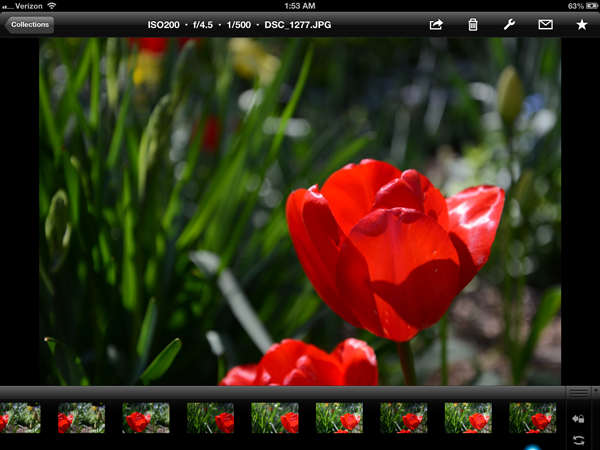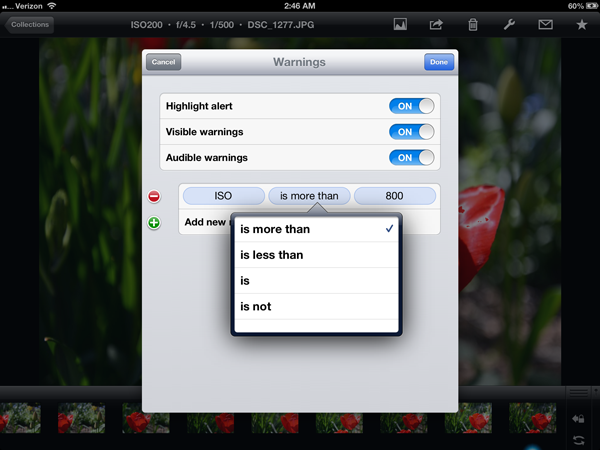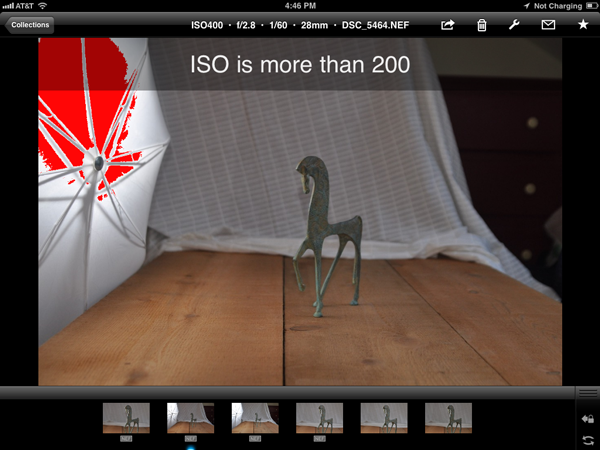ShutterSnitch, the Wireless Photo Assistant for iOS

The iPad offers several advantages for photographers. Compared to a laptop, it takes up less space and weight in a camera bag and its large screen—even on the iPad mini—provides a better view of your photos than the LCD on the back of most cameras.
It’s also great for reviewing photos on-site. Instead of setting up a laptop and tethering the camera using cables, images can be transferred to the iPad wirelessly while you shoot in conjunction with a Wi-Fi memory card such as the Eye-Fi or the Toshiba FlashAir, adapters such as Nikon’s WU-1b or Canon’s WFT (Wireless File Transmitter) devices.
Naturally, each manufacturer has its own iOS software for grabbing those images, and naturally the quality of those apps is all over the map. Instead of struggling with them, turn to ShutterSnitch, a $19.99 app for the iPad, iPhone, and iPod touch that not only facilitates smooth image transfers, but proves itself as a helpful photographer’s assistant. (For clarity, I’ll refer to working just on the iPad, but the features translate to the iPhone and iPod touch as well.)
Wireless Transfers
ShutterSnitch can communicate with a host of wireless devices: Eye-Fi cards; Canon WFT, Nikon WT, and other FTP transmitters; Nikon WU adapters; the Canon 6D camera; Panasonic LUMIX LINK cameras; Transcend Wi-Fi cards; Toshiba FlashAir cards; and PQI Air cards. A detailed setup guide walks you through the process of connecting to each type.
In my experience, ShutterSnitch has been the most reliable tool for transferring photos, which alone justifies the app’s price. Connect the iOS device to the ad-hoc Wi-Fi network created by the wireless card or adapter, create a new Collection (a virtual container to store new images) in ShutterSnitch, and then begin shooting. After each photo is saved to the camera’s memory card, it’s sent to ShutterSnitch and displayed full screen (Figure 1). The transfer time depends on the size of the image file, but typically the image appears after only a few seconds. You can also keep shooting while the file is being copied.

Figure 1. Photos imported into ShutterSnitch
ShutterSnitch can work with raw files as well as JPEG files, but there’s a catch: iOS doesn’t read native raw files. Instead, the system displays the low-resolution JPEG preview the camera creates. If you open a raw file in an image editor such as Snapseed or iPhoto for iOS, the adjustments you make are to that JPEG preview.
A handful of apps exist that can process raw files, such as piRAWnha, but the size of the files and the computation required to apply raw adjustments quickly overwhelms the relatively small amount of memory and image processing power of most iOS devices.
The workaround is to shoot in Raw + JPEG mode, which creates two files for each photo you shoot. The JPEG file’s resolution is high enough for editing and sharing on the iPad. To ensure that you don’t swamp your iPad with large raw files, ShutterSnitch includes a setting to receive JPEG files only. That gives you much smaller files to work with, while keeping the raw originals on the memory card for importing into your computer later.
Photographer’s Assistant
Moving images from camera to iPad is certainly helpful, but ShutterSnitch is designed to do more than act as a shuttle. Part of the point of viewing images on the iPad as they’re captured is to evaluate their quality. Is the exposure correct? Do you notice distractions in the background that may not be easily seen in the camera or on the LCD?
ShutterSnitch displays the ISO, aperture, and shutter speed for each shot, and you can also display a highlight clipping indicator and a histogram. You can also set up customized warnings that alert you to other factors. For example, if you were shooting in low light the night before and cranked up the ISO, ShutterSnitch can warn you if the setting is more than, say, 200 for today’s daylight shooting (Figure 2). You can specify warnings for ISO, shutter speed, aperture, focal length, and light level.


Figure 2. ShutterSnitch can warn you when you’ve forgotten to reset the ISO.
You can also set up Actions that automatically perform tasks such as renaming incoming images, applying metadata such as copyright information, resizing the photo (which replaces the original, so take care), or exporting a copy of the image to a service such as Dropbox. Those actions can be chained to apply several actions in succession, and you can even set up conditions such as: “If ‘Focal length’ is less than ‘24mm’ then perform task ‘Move to Landscape Collection.’”
Presentation and Sharing Tool
You may not be the only person viewing photos as they come out of the camera, so ShutterSnitch can pivot to become a presentation tool. In addition to an obligatory Slideshow feature, you can apply star ratings to start culling and elevating certain shots, view the photos cropped to an aspect ratio of your choice, or display an image overlay on each shot (with a custom level of opacity in case you want a subtle approach).
A Limited Mode requires a password and controls what actions can be taken, which is great if you’ve handed the iPad to a client to review the shots. You can choose to let them rate photos, for instance, but not print, delete, or email them.
If you have an HD television connected to an Apple TV or appropriate video cable adapters, you can project ShutterSnitch’s output onto the television; a setting lets you decide whether to mirror the ShutterSnitch screen, enabling you to see all controls on the television, or to display just the images themselves.
Architecturally, ShutterSnitch stores photos in its own protected storage space in iOS; unlike importing photos using an iPad Camera Connection Kit or Lightning adapter, images don’t go to the system-level Photos library. That gives the app more control over what it can do with the photos, but also requires that you take action if you want to share or export the photos.
In addition to being able to copy images to the Camera Roll or to send them via email, ShutterSnitch can export pics to another location such as a Dropbox account. It can even group photos into a compressed .zip archive to be opened in apps that support the format.
Depending on how much work you want to do with your images on the iPad, ShutterSnitch may be the only tool you need to review and share shots before you get back to your computer.
This article was last modified on July 20, 2021
This article was first published on June 7, 2013



